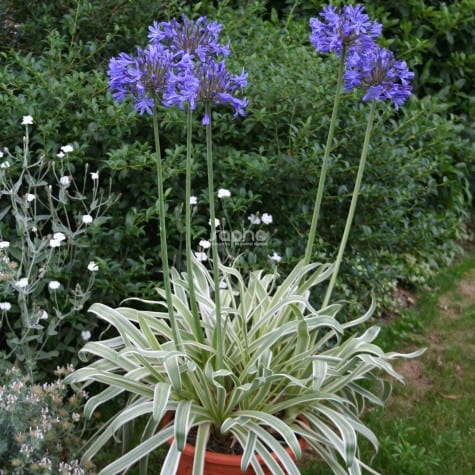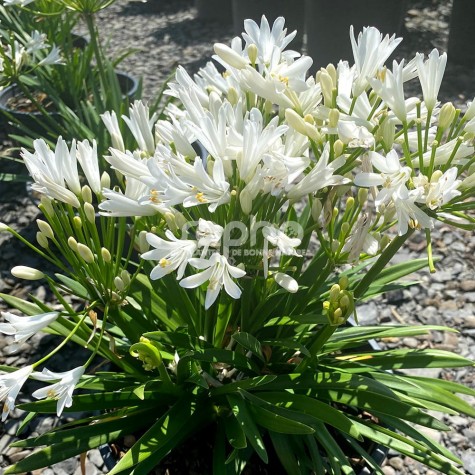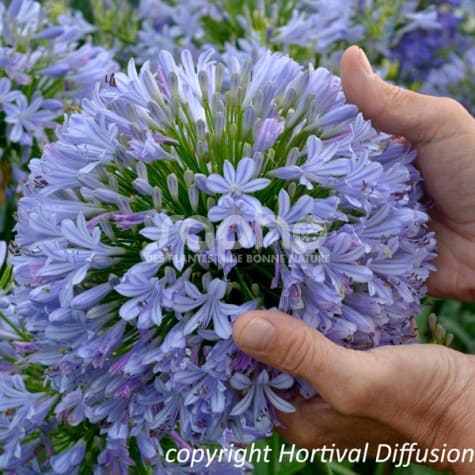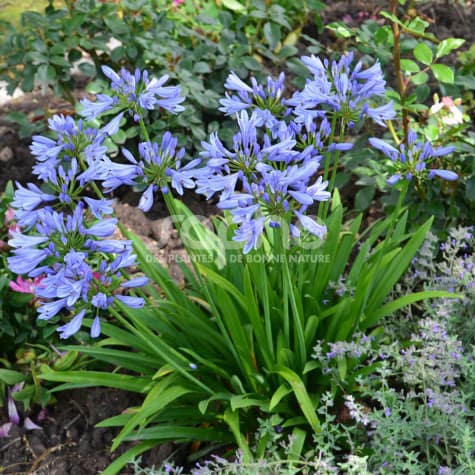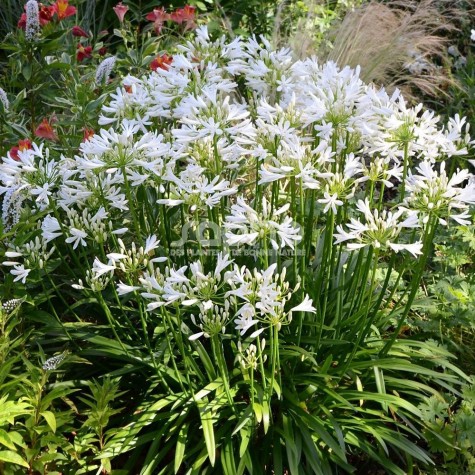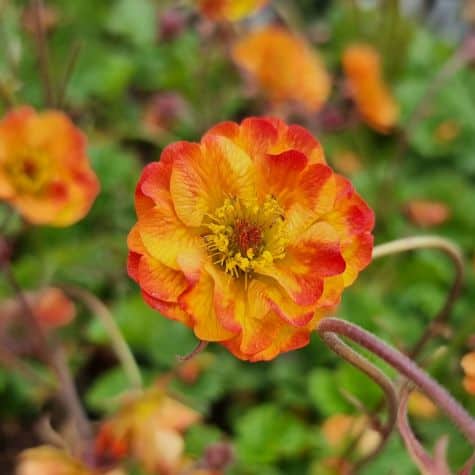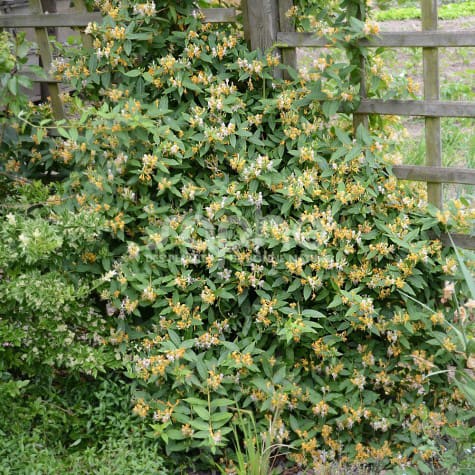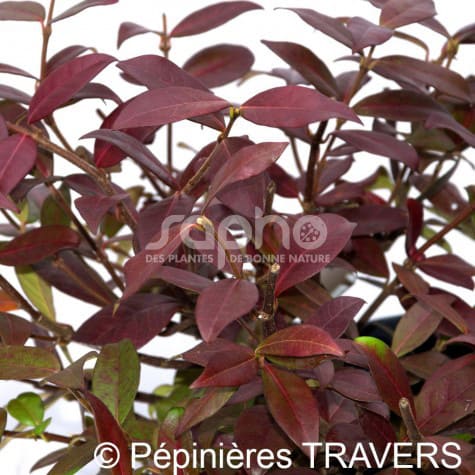A stylish variegated agapanthus!The evergreen BLUE PANACHE® is remarkable due to its bright foliage and a beautiful variegation. The leaves are 30 to 35 cm long and 2 to 3 cm wide. The green-grey leaf blade is widely edged in white and irregularly striated.The plant is vigorous and of a big developpement. In June and July 70 to 80 cm long floral stems carry beautiful blue inflorescences with more than a hundred flowers. The variety is sterile.Like all Agapanthus, BLUE PANACHE® loves rich and well-drained soils and tolerates droughts and chalk.It prefers sunny positons but also flowers well in half-shade.The plant must be protected in cold climatic zones (temperatures below -5° C).
Filter By
Foliage
Position
Where to find Sapho plants ?
For young plants
You will find the names of Sapho-licensed nurserymen at the bottom of each variety sheet.
For available plants
Please ask your nursery suppliers.
Each licensed propagator is free to market his young plants to all his customers.
Categories
Menu
All our varieties
A firm-favourite agapanthus that’s pocket-sized and abundantly flowering
This variety of agapanthus is very compact! It quickly forms a clump, while remaining small in size.
Ultra-compact and flowering from an early age, it produces large, pure white flowers borne on short, sturdy flower stalks! (10 to 15 cm)
Its attractive green foliage is evergreen.
Its unusual format means it can be used in a composition, pot, window box or bed, in association with other perennials.
🥇 Gold winner of the Innovert 2024 competition
Extraordinary globes of limitless blue flowers, more than 30 cm in diameter
The exceptional flowerheads of Agapanthus BLUE INFINITY® can reach more than 30 cm across! The countless florets in each bloom and the development of new flower spikes throughout the summer prolongs flowering « to infinity ». The clear blue colour typical of the Agapanthuses is here enhanced with central stripes of dark blue on each petal. BLUE INFINITY® is a tall variety with stout stems, reaching to between 1m and 1,50m. This Agapanthus is a garden wonder.It can be grown directly in the soil in temperate zones or in pots.
PITCHOUNE® Blue, a beautiful blue and compact African lily.
This Agapanthus presents all the qualities of the PITCHOUNE® range. Made up of numerous flowers, these umbels are bigger and of a deeper blue than those of dwarf Agapanthus praecox; they bloom in June - July, their flowering is good.The leaves are wide and evergreen.PITCHOUNE® Blue will have a nice summery effect, planted outside in areas of temperate climate, or in pots.
From the PITCHOUNE® range, a vividly reblooming white agapanthus
This Agapanthus presents all the qualities of the PITCHOUNE® range.The first white very dense umbels open in June-July. It's an exceptional variety due to its renewed flowering until early September, under good conditions.Thanks to its reduced dimensions, its evergreen foliage and long and dense flowering, PITCHOUNE® White is ideal, grown in pots or in the soil in areas of temperate climate.
“Flashy" flowering, which illuminates the beds from late spring to mid-summer
This compact perennial variety offers a combination of single or semi-double, scalloped flowers in a variety of warm, luminous colors: yellow, orange, red.
What's more, it's hardy and evergreen in mild climates.
Place in the sun, at the edge of a bed, rockery or in a pot.
Ever, always: dense foliage even in winter, fragrant flowers in summer, bluish fuits in autumn.This variety of climbing honeysuckle of our CAPRILIA ® range is a hybrid between Lonicera henryi and Lonicera japonica 'Aureoreticulata'.CAPRILIA ® Ever is hardy and shows good persistence in winter.This selection shows a lesser development than its parent plant Lonicera henryi.The plant flowers well in May - June, presents clusters of small flowers which stand out well against the foliage. Light violet to pink as buds and in bloom, the flowers then turn yellow orange before wilting. They are fragrant, unkike Lonicera henryi. Some second flowering is noticeable in September.Dark blue fruits appear at the end of summer and persist for a long time.The narrow, mid-green foliage resists well to blackspot, mildew and aphids.To be trained.
Perfumed flowers in summer and a superb coral-red foliage in winter
In winter its stems and foliage acquire a pronounced, beautiful and decorative coral-red all through the height of the plant.In addition to its winter colours, Trachelospermum jasminoides Winter Ruby® has other advantages over typical jasmines. Its elegant foliage is livelier and brighter. It resists frost better (as low as -17°C), is more persistent and retains its leaves better which don't dry out in winter.Its generous white flowers bloom slightly earlier (between May and July in full sun, from June to September where it's partly shaded) and are all just as perfumed. It doesn't grow as tall (2 to 3 m) as typical jasmines (up to 5 m or more).For its compact form, its natural branching and abundant flowering, Winter Ruby® is an ideal variety for growing in pots with supports of 40 cm to 1.5 m.

